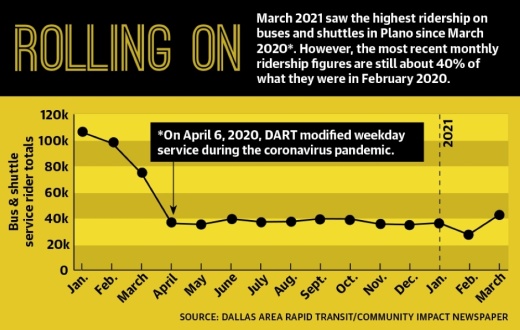The new DARTzoom program has been designed to improve service frequency and hours buses are available in areas with the heaviest ridership. Plano riders will see revisions to a number of the city’s routes and the services offered, but DART officials expect the city’s coverage area to see little change overall.
Plano resident Mike Ed, who uses DART buses as his main mode of transportation, said he was happy to hear about the planned redesign.
“Anytime they can improve the system, in terms of service, comfort and security, I think that’s really good,” he said. “It makes people want to use the [DART] system.”
The increase in frequency of buses could also help bring passengers back, Ed said he believes. Since the onset of the coronavirus pandemic, he said he has seen more people opting to drive their cars than ride DART buses.
Bus service during peak usage hours in Plano is currently “very limited,” according to Rob Smith, DART’s assistant vice president of service planning and development. Weekend service in the city is also not as extensive as during the week, he said.
“Under this proposal, all of our local bus routes will operate seven days a week for the full hours that they’re normally in operation,” Smith said. “Many of them will operate more frequently.”
Planned changes
The biggest change Plano residents are likely to see, Smith said, is the expansion of DART’s GoLink service, which offers on-demand shuttles, in a pair of zones being added to the city. According to the agency’s website, the charge for a GoLink ride is the same as a regular DART bus fare.
“The GoLinks are really popular, especially on the northern side [of the city],” Plano Director of Special Projects Peter Braster said. “They’re some of the best-ridden in the DART system. Once people understand what they can do and how much more convenient they are than waiting for a bus, I think it’ll be much better for them.”
The DARTzoom plan shows the agency adding two GoLink zones in Central Plano and East Plano to give the city a total of five. The Central Plano zone will cover portions of three current bus routes. The other zone will cover portions of two existing bus routes in the eastern portion of the city and extend into Richardson.
“We will have more [GoLink] coverage [in Plano],” Smith said. “There will be areas like East Plano, where we’ve had very limited service historically, that will be offering GoLink service over a much wider area.”
GoLink coverage in East Plano has been a frequent request, he said.
“We’re expanding the North Central Plano zone to cover neighborhoods in more northeastern parts of Plano,” Smith said. “So overall, we end up with more coverage with these GoLink changes in particular.”
The revamps of current Plano bus routes are being proposed to improve efficiency, Smith said. Another major feature of the redesign is the expansion of weekend service, he said.
The GoLink zones covering the Legacy area and North Central Plano are expected to be part of that expansion. In both areas, DARTzoom shows the service proposed to be offered on Saturdays as well as weekdays. Plano’s other GoLink zones would be available only Mondays through Fridays.
“What we are really trying to do, whether it’s Plano or really any of the 13 cities [in DART’s service area], is be able to get people to more places—whether those be jobs or places that they want to go—in a given amount of time,” Smith said.
Local services
At a community meeting for Plano residents in early April, the agency received input on the planned changes from the public and the city. Under the proposed changes, Braster said most Plano residents will see an increase in the services available to them, and fixed route buses will “come by more often.”
Those improvements and the expansion of GoLink service should be especially beneficial to seniors who rely on DART to get around, he added.
“[Seniors] don’t have to wait around or call up a day before,” Braster said. “They can call up [a ride] on their app within minutes.”
Braster said people commuting in the Legacy area of the city are also some of the most frequent riders in Plano. One major patron of the DART bus network in that area is Southern Methodist University’s Plano campus. Vice President of External Affairs Brad Cheves said the university sees DART as a benefit to its students and staff.
“Even as that [campus] becomes smaller and we disperse into other education centers across Plano, [DART] still will be a vital strategy and partner for us as we continue to help our students, faculty and staff commute and engage,” Cheves said.
On the east side of Plano, Collin College’s campus on Spring Creek Parkway is also a frequent destination for students riding DART buses.
“We’ve heard many times when students have to drive even 20 minutes to a campus, it may prohibit their availability to take classes,” Campus Provost Mary Barnes-Tilley said.
She said the improved frequency of buses that is part of the DARTzoom plan will benefit students who do not have access to a personal vehicle.
“Addressing that is really going to be beneficial to our students because right now we offer classes starting at 7 a.m., and we run them until almost 11 p.m. in the evenings,” she said.
Planned implementation
In addition to community meetings, DART has an online public survey for feedback on the proposed bus network changes. That will be available through June 22, when the agency has a final public hearing for the plan scheduled for its board of directors meeting.
“That, basically, is the conclusion of the public input process for the proposed changes,” Smith said. “We’re going to be taking all the comments that we’ve heard ... and assess whether we need to make adjustments to the proposal. I expect that we will make adjustments.”
The DART board will then have the opportunity to approve any further changes to the proposal in August. If all goes as planned, Smith said DART is scheduled to implement the revised bus network Jan. 24.
Once the agency receives approval from its board, Smith said DART may have to change out all of the nearly 10,000 signs in its service area.
DART personnel will also have to create new system maps, new passenger timetables and work to update Google Maps and other trip-planning software, Smith explained.
“We [will] spend [those] four or five months getting all of those things ready so that we can make that one big changeover in January,” he said.







